
The Glass Bowl is a circular glass vessel discovered at Qaryat al-Faw Archaeological Site , an ancient civilization in the Arabian Peninsula. The site is located in the southeastern part of Wadi ad-Dawasir Governorate in Riyadh Province , Kingdom of Saudi Arabia. The bowl dates back to the third century BCE and was used as tableware. Specifications and dimensions of the glass bowl It features a rim that extends vertically along the body’s walls and a circular base. The exterior surface is ado...
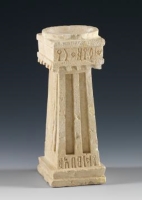
The Limestone Censer is an ancient censer carved and made from limestone, used for burning incense and aromatic plant materials. It was discovered in Qaryat al-Faw , one of the archaeologically rich sites located southeast of Wadi ad-Dawasir Governorate in Riyadh Province , in the Kingdom of Saudi Arabia. It is one of the artifacts selected to be showcased in the Saudi Archeological Masterpieces Through the Ages Exhibition held at the Louvre Museum in 2010. Description of the limestone censer T...
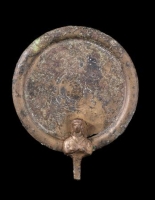
A Bronze Mirror is an ancient mirror made of bronze, featuring a round shape with a raised, twisted rim. It was discovered in archaeological Qaryat al-Faw , at the intersection of Wadi ad-Dawasir and the Tuwaiq Mountains in the southeastern part of Wadi ad-Dawasir Governorate , in Riyadh Province , in the Kingdom of Saudi Arabia. The site is rich in historical artifacts. The inner surface of the mirror features decorations consisting of a cavity and several circles with grooves in the center, e...
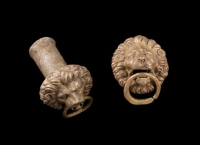
Two Bronze Statue Heads are ancient artifacts used as decorative ornaments. They were discovered in archaeological Qaryat al-Faw , one of the historical archaeological sites of past civilizations, located southeast of Wadi ad-Dawasir Governorate in Riyadh Province , in the Kingdom of Saudi Arabia. The two statue heads consist of two bronze ornaments made of copper, shaped as a lion’s face gripping a circular bronze bracelet between its jaws. A circular groove surrounds the back of the head, w...
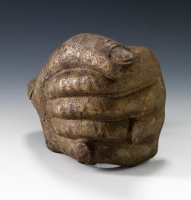
The Bronze Fist is an artistic piece consisting of a wrist, a clenched hand, and five fingers made of bronze with a rough outer texture. The fingers are tightly closed together, secured by the thumb, and a ring is visible on the ring finger. It was discovered in the archaeological Qaryat al-Faw , a site rich in historical artifacts from past civilizations, located in the southeastern part of Wadi ad-Dawasir Governorate in Riyadh Province , in the Kingdom of Saudi Arabia. Dimensions of the bronz...
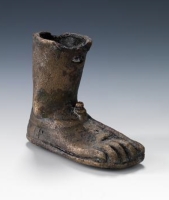
The Bronze Foot and Leg is an ancient artistic artifact made of bronze, shaped like a human foot and leg. The toes are clearly defined, along with the sole, and it was used as an offering. It was discovered in the archaeological Qaryat al-Faw , southeast of Wadi ad-Dawasir Governorate , in Riyadh Province , in the Kingdom of Saudi Arabia. Dimensions of the bronze foot and leg Height: 8.5 cm. Foot length: ten cm. Foot width: four cm. History of the bronze foot and leg artifact The bronze foot an...
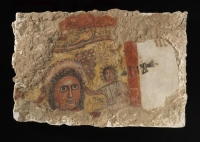
The Plaster Mural is an ancient colored plaster panel with a yellowish background, discovered in the archaeological Qaryat al-Faw , the capital of the first historical Kingdom of Kinda. It is located southeast of Wadi ad-Dawasir Governorate , in Riyadh Province , in the Kingdom of Saudi Arabia. The plaster mural features decorations consisting of an image of a man with thin, long mustaches and bulging eyes. His head is crowned with a wreath, and a vine branch is positioned above him, with a clu...
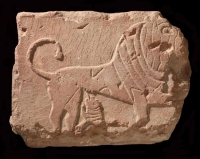
The Sandstone Sculpture is a rectangular block of stone, found in Wadi al-Hamd, at the site of Khirbat Dadan, in AlUla Governorate , in al-Madinah al-Munawwarah Province. It is one of the most important cultural and civilizational heritage sites in the Kingdom of Saudi Arabia. The sculpture features a protruding carving of a lioness standing on its four legs, with an atrophied belly, stringy hips, and a tail raised upwards and curved forward in the form of an incomplete circle, with its tip han...
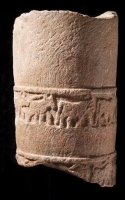
The Sandstone Censer is a carved pinkish sandstone censer. It was found in Mount Umm al-Daraj, in AlUla Governorate , in al-Madinah al-Munawwarah Province . It has a cylindrical body topped by a square basin. Two of its four sides protrude from the column. The lower part of the crown features triangles with their vertices facing upwards and featuring consecutive hollow carvings. The column is divided into four bands, the first band is located directly under the basin and features no ornamentati...
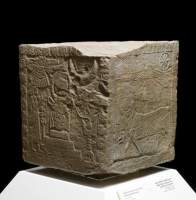
The Cubic Stone is a cubic stone missing a small part of its upper right corner. It was found in Tayma Governorate , in Tabuk Province , north of the Kingdom of Saudi Arabia. It is carved from sedimentary sandstone. It offers a view of various consecutive ornamentations, featuring relief carvings on two of the six sides of the stone. The left side of the stone features a frame ornamented with recurring protruding carvings of plants. Under this side, a carving of a star placed within a circle is...
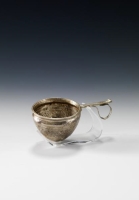
The Oval Silver Ladle is a small ladle made of silver shaped like an oval bowl. It was discovered in the archaeological Qaryat al-Faw , located southeast of Wadi ad-Dawasir Governorate in Riyadh Province , Kingdom of Saudi Arabia. Description of the ladle The silver ladle has a pointed base, an inward-curving shoulder, and a neck that stands on the shoulder with a slight outward tilt. On its outer surface, below the shoulder, there are two parallel lines encircling the body of the ladle, eac...
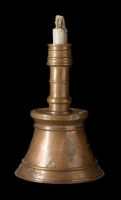
The Copper Candlestick Artifact is a cone-shaped candlestick made of copper that was endowed to the Prophet’s Mosque . The candlestick widens at the base and narrows toward the top. It has a base with an outwardly protruding edge, featuring a groove at its center. Above this base is another prominent edge encircling the body of the candlestick, and ends with a protruding rim encircling the body of the candlestick again. The neck flares outward and culminates in an upright edge. The long neck ...